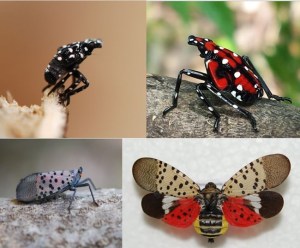What Can I Treat?
 FUNGAL DISEASES
FUNGAL DISEASES
Chemjets are ideal for treating common fungal diseases such as Oak wilt, Dutch Elm Disease, or Laurel Wilt to name a few. Using propiconazole 14.3% MEC (Alamo, Quali-Pro, Prime Source) mixed in a 50/50 solution and injected proactively is always recommended, although trees can be treated therapeutically if caught in the earliest stages of the disease.  Nitidulid beetle spreads Oak wilt
Nitidulid beetle spreads Oak wilt
 Redbay Ambrosia beetle spreads Laurel wilt
Redbay Ambrosia beetle spreads Laurel wilt
 Elm bark beetle spreads Dutch Elm disease
Elm bark beetle spreads Dutch Elm disease
Root Rot, Chlorosis, and other deficiencies


Root rot in trees is a common disease that is often overlooked or attributed to another disease or mistaken as tree mortality. There are two distinctive root rot pathogens, Phytophthora and Cotton(Phymatotrichum). Phytophthora spp. is a soil-borne pathogen called an oomycete or “water mold”. Once thought to be a fungus, it is now known to be a separate species, ranging in the hundreds, responsible for considerable destruction to all types of plants and trees. Most are host specific like Sudden Oak Death (SOD) which is caused by Phytophthora ramorum. Phytophthora cinnamomi can infect thousands of species of plants and is found in 70 countries. Cotton Root rot is a fungal pathogen that affects crops and trees(fruit, nut, and shade) and can cause rapid death if not addressed as soon as possible.
Potassium phosphite is an effective fungicide for treating root rots. Product names such as Phostrol, ArborFos, or Reliant are available. Only a few are listed for trunk injection on the label so be sure to read it before you purchase. Although the percentage of the chemical is similar, it is the “inactive” ingredients that may have adverse effects when trunk injecting. I tend to stick with those products that are listed but it is up to you.
A maximum of 5 ml of product for every 2″ of diameter is what I recommend regardless of the mixing instructions on the label. I say this from experience having had tree leaves burn from too high a potency. By the way, the percentage of potassium can range from 45.8% to 53.6% which is a rather large range in the world of injecting. Also, If the tree has been pruned or trimmed or the canopy is diminished then use fewer injectors or you could damage the leaves as well.

Chlorosis is the lack of chlorophyll caused by various conditions including nutrient deficiency.
Iron, manganese, and nitrogen are just a few nutrients that can be injected into a tree to help with chlorosis or stunted leaf growth.
Always check your product label for the proper ratio. I recommend not doing more than 3 ml of product every 2″ of diameter to avoid any toxicity or leaf burn.
 INSECTS
INSECTS
The Emerald Ash Borer(EAB), Asian Longhorn Beetle(ALB), Pine Bark Beetle, and Hemlock Woolly Adelgid(HWA) are some of the most common destroyers of trees. The Spotted Lanternfly is among the latest insect invaders to devastate trees.
Imidacloprid (Ima-Jet/Imicide hp) or Emamectin Benzoate (TreeMec/Tree-age) are proven effective in proactively treating trees. There are also a variety of other insecticides that are broad-spectrum and can be used to treat a variety of pests that invade trees. It is important to treat a few weeks before the insects are known to invade. It is also necessary for the leaf to be developed in order for the tree to draw up the solution from the injections, usually in early spring. When using Chemjets to inject insecticide it is helpful to know how much to use per injector. Most labels don’t have that information. After researching many different insecticides, we have determined that a safe ratio of 1:4 ml of insecticide to water per Chemjet applied every 2″ of diameter will produce effective results. This is only a guideline to help. Do the research into the product you use to ensure proper protection.
 BACTERIAL DISEASES
BACTERIAL DISEASES
Bacterial diseases can be tricky to treat. Anthracnose(leaf blight) is one of those bacterial diseases that can be treated by trunk injection using a fungicide or bactericide. Bacterial Leaf Scorch can be treated with tetracycline to control the disease but must be administered on a yearly basis as it does not cure the disease, only alleviates the symptoms during the year. The University of Florida has started using Chemjets for Citrus Greening, a bacterial disease spread by insects, due to its ease of use on smaller-diameter trees.

